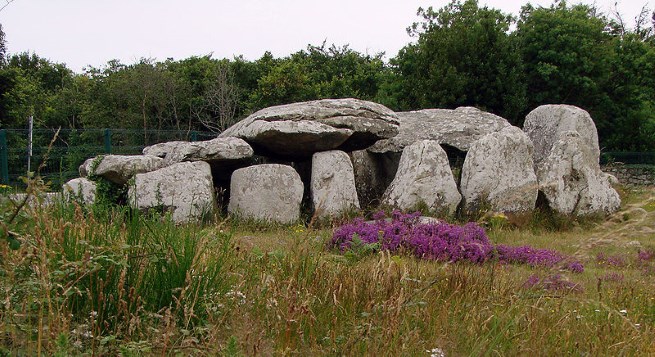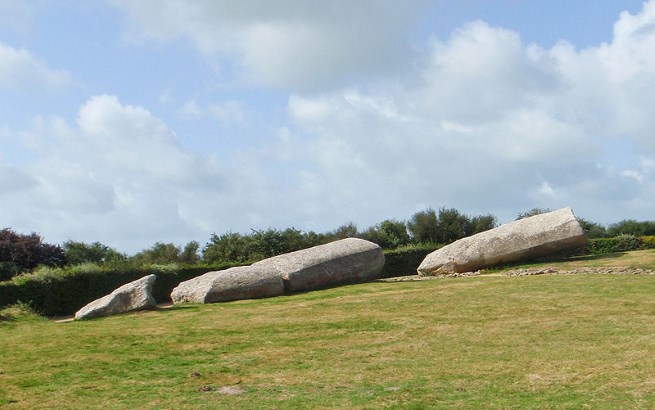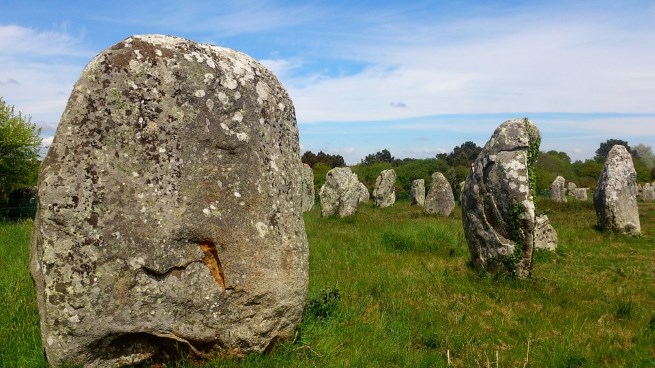Humans have occupied Armorica since the Palaeolithic era. Living originally as hunter gatherers, the population became settled in the Neolithic period (around 4500 BC), gradually mastering the techniques of raising livestock, cultivating crops and building. This was the civilisation that created the tradition of standing stones. Most of the megaliths (dolmens, tumulus, and menhirs) were constructed between 4500 and 200 BC. With almost 3000 standing stones spread over several sites, Carnac displays some of the greatest vestiges of megalithic art.
Dolmens
Dolmens, meaning stone table in Breton, were once used as collective sepulchres. They comprise monumental stones raised as basic stone tables, covered alleyways or corridors leading to a mortuary chamber. Some dolmens are decorated with various motifs: idols, snakes, crosses or axes, and elaborately engraved, such as the one at Gravinis, in the Gulf of Morbihan. Initially they housed some 15 dead, perhaps all members of the same family, or eminent personages, but by the end of the Neolithic, they sometimes accommodated the bones of hundreds of people. The dolmens had a cultural purpose and were associated with funerary rites celebrating the passage from life to death. Frequently they were established at remote sites, thus reinforcing the secret nature of these rites.

Dolmens at Carnac, photo: Vassil
Tumulus and cairns
A tumulus is a mound of earth and stones covering a mortuary chamber. The internal structure is in wood and small stone slabs. Within the family of collective sepulchres, the most highly structured is the cairn, constructed using stone blocks forming dry stone walls. This juxtaposition of compartments indicates that cairns were the sites of various types of ceremony. Tumulus and cairns, generally constructed at sites visible from afar, were of symbolic importance, and the central point of the community. That of Er-Grah, at Locmariaquer in Morbihan is one of the largest, almost 200 m long.
Menhirs
From the Breton word meaning long stone, menhirs are even more numerous and mysterious than the dolmens. Isolated or in groups, they may be arranged in a straight line, in alignment or in a circle. Their size ranges from a few centimetres to more than twenty metres. The spacing between the stones, their orientation and the outline they define was certainly of ritual or astronomic significance. Reference has been made to religious rites linked to the cult of fertility, or ceremonies in honour of the sun, etc. Their location does not appear to be the result of random hazard, but fulfils a real function. The alignments at Carnac, for example, appear to indicate the positions of the sun throughout the year.
Advanced technology
The construction of the megaliths implies the existence of efficient technical resources. Some of the stones, such as the great menhir of Locmariaquer, weigh 350 tonnes; the average stones exceed 50 tonnes. They had to be extracted from the ground and transported several kilometres to be raised at the desired site. They were moved using simple systems of logs, ropes, levers and inclined surfaces.

The Broken Menhir of Er Grah, photo: Bjørn som tegner
The cairn of Gavrinis
Located on an islet of some 15 hectares in the Gulf of Morbihan, the cairn of Gavrinis is acknowledged as the finest in the world in terms of the richness of its decoration. This cairn, 100 m long and 8 m high, covers a great corridor dolmen, forming a gallery 14 m long and 1.50 m wide leading to a square funerary chamber. The beauty of this monument, dating from the 4th century BC, indicates it was probably a royal sepulchre.





REPLY
REPLY